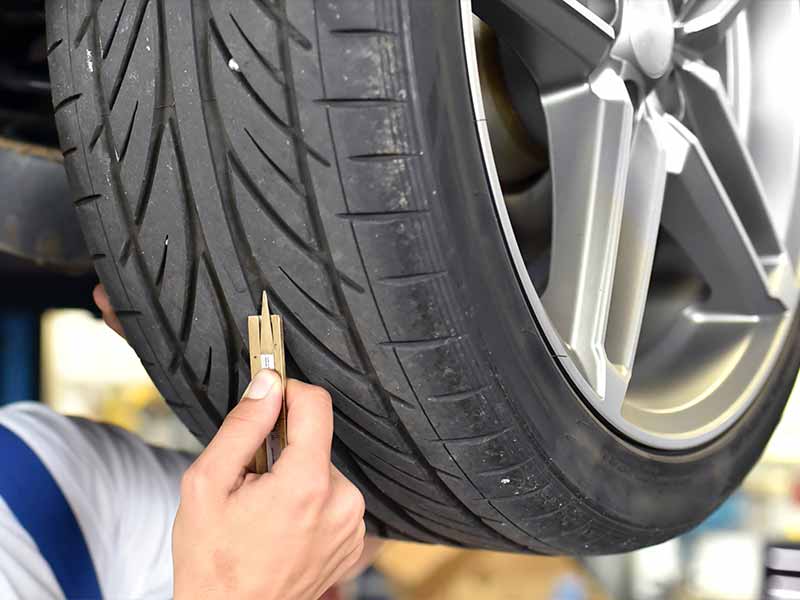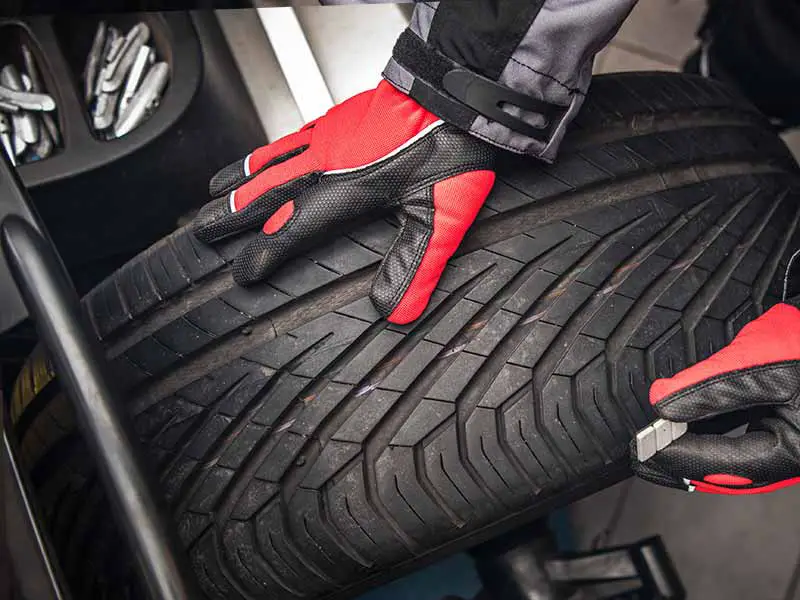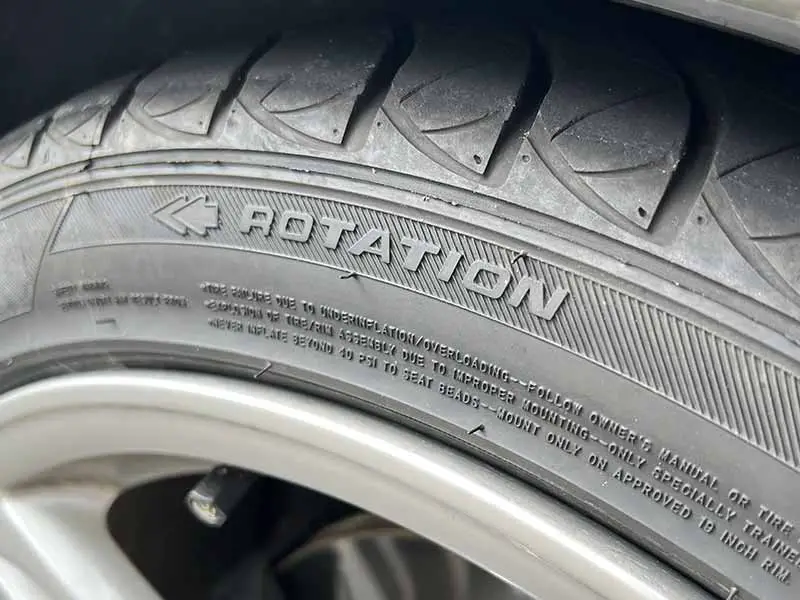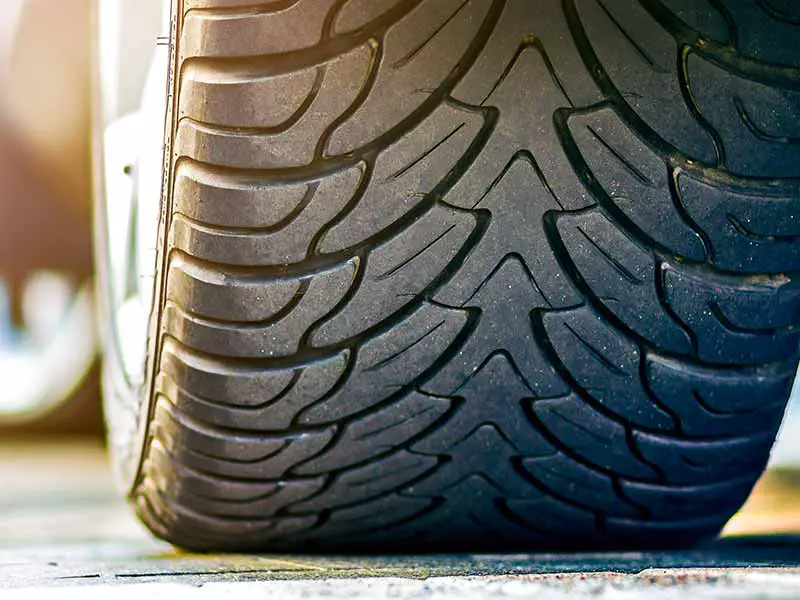Directional tire tread patterns have become increasingly popular in recent years, particularly for high-performance vehicles, thanks to their ability to provide excellent handling and performance in wet conditions.
However, they have some limitations, including limited rotation options and less effective performance in snowy or icy conditions.
What Are Directional Tires?
A directional tire has a V-shaped tread pattern that’s optimized for wet weather conditions and can roll in only one direction to work correctly. That means you can’t switch them from one side of the car to the other, but the benefits they provide make up for this limitation.
In this article, we’ll take a closer look at directional tires, including how they work, their pros and cons, and how to tell if your tires are directional.
Let’s take a closer look.

How Do Directional Tires Work?
Directional tires have a unique tread pattern that’s optimized for wet weather conditions. The tread usually looks like a “V” shape with grooves that help to disperse water away from the tire and reduce the risk of hydroplaning.
When you’re driving in wet conditions, the water on the road can create a thin layer between your tires and the pavement, which reduces traction and makes it harder to control your car. But with a directional tire, the grooves in the tread help to channel water away from the tire and keep it in contact with the road surface, improving traction and safety.
Another benefit is that they’re usually quieter than other types of tires because of their unique tread pattern. The way the grooves are designed helps to reduce road noise and provide a smoother ride.
To get the most out of your directional tires, it’s important to make sure they’re installed correctly. The direction of rotation is usually indicated by arrows on the tire’s sidewall, so make sure you’re installing them the right way. It’s also important to rotate them regularly to ensure even wear.
Since you can’t switch them from side to side, you’ll need to rotate them front to back. And as with any type of tire, regular inspections and maintenance are key to keeping them in good condition.
Directional Tires Vs Non Directional
Directional and non-directional tires each have their pros and cons, and the right choice for you will depend on your driving needs and preferences.
As we’ve discussed, directional tires are designed to only roll in one direction. They have a specific tread pattern optimized for wet weather conditions and are usually quieter than unidirectional tires. They also tend to wear more evenly and last longer than non-directional tires. However, they are usually more expensive and have limited rotation options.
On the other hand, non-directional tires can be rotated in any direction, which means they wear more evenly and can last longer if rotated properly. They also tend to be less expensive than directional tires. However, their tread patterns are not optimized for wet weather conditions, so they may not provide the same level of traction in rainy or snowy conditions. They also tend to be noisier.
When choosing between these two tread patterns, it’s important to consider your driving needs and the conditions you’ll be driving in. If you live in an area with a lot of wet weather, directional tires may be a better choice for you. If you’re on a budget, non-directional tires may be a better option. And if you’re looking for a tire that can be rotated in any direction and is versatile in different weather conditions, all-season tires may be a good choice.

Directional Tires Vs Asymmetrical Tires
Directional and asymmetrical tires are two different types of tires, each with unique characteristics and benefits. While directional tires are designed to rotate in one specific direction, asymmetrical tires have a tread pattern split into two distinct halves, each designed to provide specific performance benefits.
Directional tires are often chosen for their excellent wet weather performance, thanks to their unique tread pattern that can channel water away from the tire and improve traction. However, they may not perform as well in snowy or icy conditions, and their limited rotation options can make them more expensive to maintain over time.
On the other hand, asymmetrical tires are designed to provide different performance benefits on different parts of the tire. Half the tread pattern is optimized for dry conditions, providing excellent handling and traction. In contrast, the other half is designed to perform well in wet conditions, with grooves and channels that help disperse water and reduce hydroplaning. This makes them a versatile choice for drivers who want a tire that can perform well in a variety of weather conditions.
How To Tell If Tires Are Directional
Look for arrows on the tire’s sidewall to determine if your tires are directional. The arrows will indicate the direction of rotation for the tire. If the arrows point in opposite directions on the left and right sides of the tire, then it’s a directional tire. If there are no arrows or the arrows are pointing in the same direction on both sides of the tire, then it’s a non-directional tire.
You cannot switch these tires from one side of the car to the other. They must always rotate in the same direction, so make sure you’re installing them correctly. If you’re not sure how to do this, consult with a tire expert or the manufacturer’s instructions.
Rotating your directional tires regularly is important to ensure even wear. Since you can’t switch them from side to side, you’ll need to rotate them front to back. Follow the manufacturer’s recommended rotation pattern to get the most out of your tires.

What Happens If Directional Tires Are Put On Backwards?
When directional tires are put on backward, the tread pattern will go in the wrong direction, leading to less grip and traction on the road. This can be especially dangerous in wet or slippery conditions, as the tire won’t be able to channel water or debris away from the tire as effectively. It can also lead to uneven wear on the tires, which can cause them to wear out more quickly and require replacement sooner.
Additionally, putting directional tires backward can cause your vehicle to pull to one side or the other, as the tire isn’t rolling in the correct direction. This can be especially noticeable at high speeds or when turning.
Can Directional Tires Be Rotated?
When rotating directional tires, it’s important to keep the tires rolling in the same direction as before. This means that the tires on the front of the vehicle will be rotated to the back, and the tires on the back will be rotated to the front. This will help ensure the tire tread pattern is still rolling in the correct direction.
It’s also important to note that not all vehicles can have their directional tires rotated. Some high-performance cars may have staggered wheels, which means the front and rear tires are different sizes. In these cases, directional tires can’t be rotated at all.
Directional Tires Pros And Cons
Here are some of the main pros and cons of directional tires:
Pros:
- Better performance in wet conditions: Directional tires are designed to channel water away from the tire, which can help improve traction and reduce the risk of hydroplaning in wet conditions.
- Quieter ride: Directional tires often have a lower noise level than non-directional tires, thanks to their unique tread pattern.
- Sporty appearance: Many high-performance vehicles come equipped with directional tires, which can give your car or truck a sporty and stylish look.
Cons:
- Limited rotation options: As we discussed earlier, directional tires can only be rotated from front to back or back to front, limiting their lifespan and increasing the cost of tire maintenance.
- Poor performance in snow and ice: While directional tires excel in wet conditions, they can struggle in snowy or icy conditions. This is because their tread pattern is designed to channel water away from the tire, which can lead to less grip on snow or ice.
- Higher cost: Directional tires can be more expensive than non-directional tires due to their specialized design and limited rotation options.
Are Directional Tires Better?
Directional tires are designed to perform well in wet conditions thanks to their unique tread pattern, which can channel water away from the tire and improve traction. This can make them a good choice for drivers who live in areas with frequent rain or wet road conditions. Whether or not directional tires are better than non-directional tires depends on your specific driving needs and preferences.
However, directional tires may not be the best choice for drivers who frequently encounter snow or ice, as their tread pattern can make them less effective in these conditions. Additionally, their limited rotation options can make them more expensive to maintain over time.
Ultimately, the best type of tire for you will depend on a variety of factors, including your driving habits, the climate in which you live, and the type of vehicle you drive. Consulting with a tire expert can help you determine which type of tire is best for your needs and can help ensure that your tires provide optimal performance and safety.
Resources
Below are some links you may find helpful when learning about tires
Final Thoughts
We hope this article has helped demystify directional tires and given you a better understanding of their unique design and benefits.
While directional tires may not be the right choice for everyone, they can be an excellent option for drivers who prioritize performance and safety in wet conditions.
Good luck and happy motoring.






